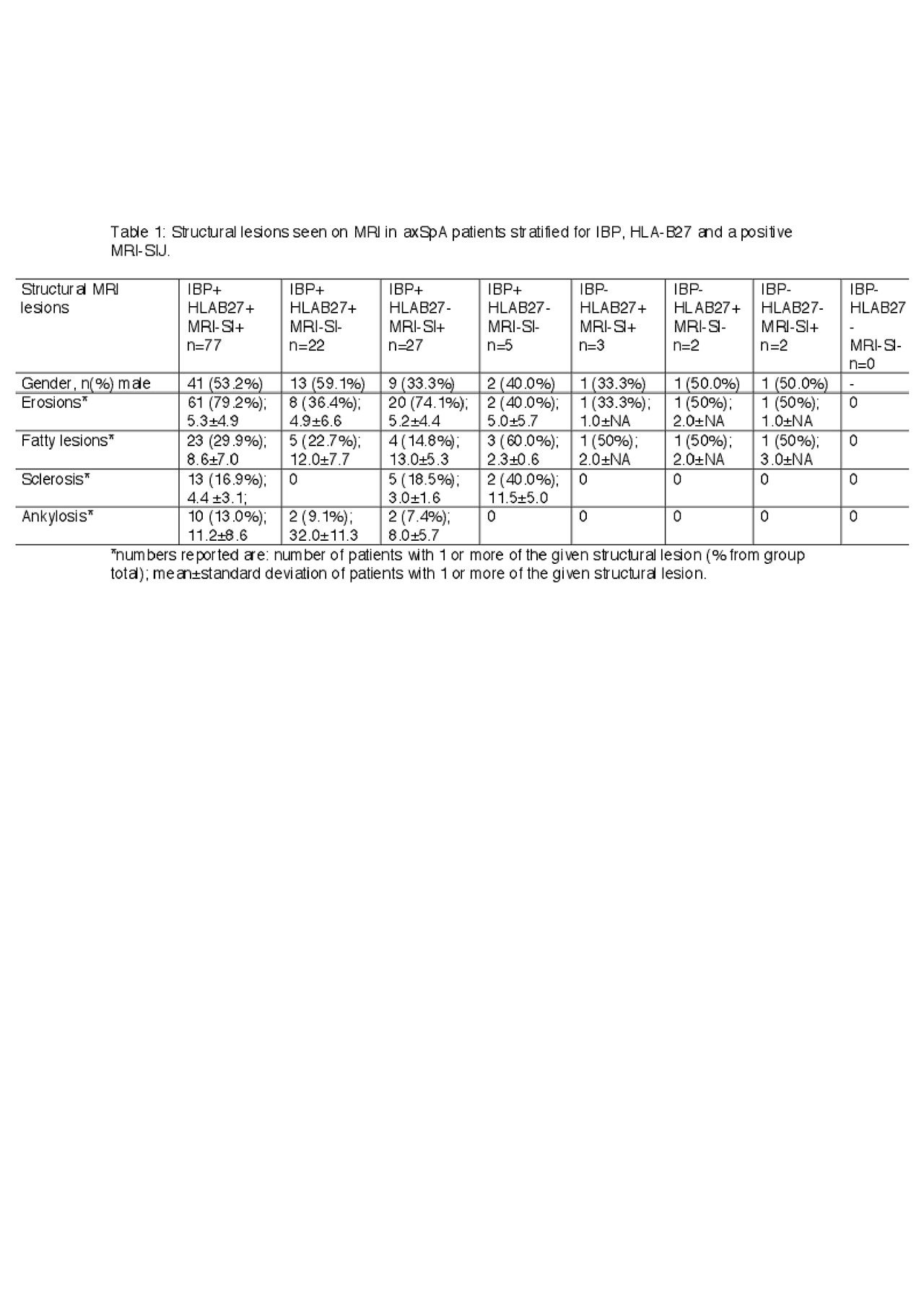Session Information
Session Type: Poster Session (Monday)
Session Time: 9:00AM-11:00AM
Background/Purpose: HLA-B27 and sacroiliitis on MRI form the basis of the Assessment of SpondyloArthritis international Society (ASAS) axial spondyloarthritis (axSpA) classification criteria. In addition, while not an entry criterion of the classification criteria, inflammatory back pain (IBP) is fundamental in the axSpA diagnostic process and it is endorsed as referral parameter in primary care. Besides inflammation on MRI, which is the hallmark of axSpA, there is still debate on the value of structural MRI lesions in these patients. The objective of this study was to report on MRI of the sacroiliac joints (MRI-SIJ) findings in newly diagnosed axSpA patients stratified for the presence of IBP and HLA-B27 positivity.
Methods: Newly diagnosed and anti-TNF naive axSpA patients of an ongoing Belgian (Be-Giant) cohort were included in this study. MRI-SIJ assessment was performed independently by 3 calibrated readers according to an adapted method of the Spondyloarthritis Research Consortium of Canada score, evaluating erosions, fatty lesions, sclerosis and ankylosis (T1-weighted and STIR images viewed simultaneously). Also, the ASAS definition of a positive MRI-SIJ was evaluated. MRI sum scores were calculated as 2 out of 3 (median) reader scores.
Results: In 138 axSpA patients MRI-SIJ data was available; 68 (49.3%) patients were male, 104 (75.4%) HLA-B27 positive and 131 (94.9%) patients fulfilled the IBP criteria according to ASAS. In the IBP+ patient groups, a large amount of structural MRI lesions were seen. In these groups, erosions are most frequently reported, with an average extent of 5 erosions. IBP- patients were rarely seen in this cohort and erosions and fatty lesions were the only structural lesions observed in these patients, with a much lower extent compared to the IBP+ patients (see table 1). There were no axSpA patients with negative MRI-SIJ, negative HLA-B27 and without IBP.
Conclusion: In this cohort of newly diagnosed anti-TNF naïve axSpA patients, structural lesions are frequently and with a high extent seen in IBP+ patients. Only in the IBP+ axSpA patients the previously reported threshold for axSpA patients of ≥3 erosions and ≥3 fatty lesions is maintained, as IBP- axSpA patients have far fewer lesions. IBP seems to be an indicator for the presence of structural MRI-SI lesions in newly diagnosed axSpA patients.
To cite this abstract in AMA style:
de Hooge M, De Craemer A, Renson T, Carron P, Deroo L, Elewaut D, Van den Bosch F. Erosions Are the Most Often Reported Structural Lesion on MRI of the Sacroiliac Joints in axSpA Patients with IBP [abstract]. Arthritis Rheumatol. 2019; 71 (suppl 10). https://acrabstracts.org/abstract/erosions-are-the-most-often-reported-structural-lesion-on-mri-of-the-sacroiliac-joints-in-axspa-patients-with-ibp/. Accessed .« Back to 2019 ACR/ARP Annual Meeting
ACR Meeting Abstracts - https://acrabstracts.org/abstract/erosions-are-the-most-often-reported-structural-lesion-on-mri-of-the-sacroiliac-joints-in-axspa-patients-with-ibp/

